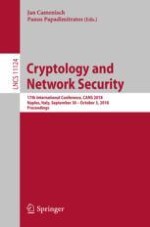2018 | OriginalPaper | Buchkapitel
Malware Tolerant (Mesh-)Networks
verfasst von : Michael Denzel, Mark Dermot Ryan
Erschienen in: Cryptology and Network Security
Aktivieren Sie unsere intelligente Suche, um passende Fachinhalte oder Patente zu finden.
Wählen Sie Textabschnitte aus um mit Künstlicher Intelligenz passenden Patente zu finden. powered by
Markieren Sie Textabschnitte, um KI-gestützt weitere passende Inhalte zu finden. powered by
